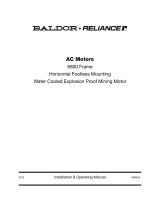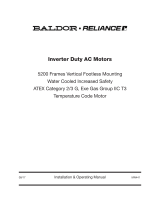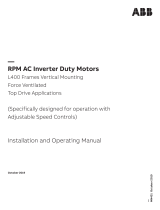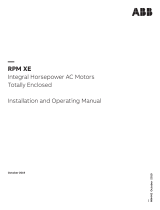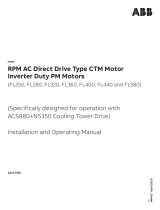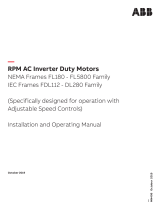Page is loading ...

1
WARNING: Because of the possible danger to person(s) or
property from accidents which may result from the improper
use of products, it is important that correct procedures be
followed. Products must be used in accordance with the
engineering information specified in the catalog. Proper
installation, maintenance and operation procedures must
be observed. The instructions in the instruction manuals
must be followed. Inspections should be made as necessary
to assure safe operation under prevailing conditions. Proper
guards and other suitable safety devices or procedures as
may be desirable or as may be specified in safety codes
should be provided, and are neither provided by ABB nor
are the responsibility of ABB. This unit and its associated
equipment must be installed, adjusted and maintained by
qualified personnel who are familiar with the construction
and operation of all equipment in the system and the
potential hazards involved. When risk to persons or property
may be involved, a holding device must be an integral part
of the driven equipment beyond the speed reducer output
shaft.
Supplemental Instructions
For the Installation, Operation of
ATEX Approved:
Dodge Sleevoil R-Series Pillow Block
Dodge Sleevoil RTL-Series Pillow Block
Dodge Sleevoil RXT-Series Pillow Block
Dodge Sleevoil P-Series Pillow Block
These instructions must be read thoroughly before installation or operation. This instruction manual was accurate at the time of
printing. Please see baldor.com for updated instruction manuals.
Note! The manufacturer of these products, Baldor Electric Company, became ABB Motors and Mechanical Inc. on
March 1, 2018. Nameplates, Declaration of Conformity and other collateral material may contain the company name of
Baldor Electric Company and the brand names of Baldor-Dodge and Baldor-Reliance until such time as all materials have
been updated to reflect our new corporate identity.
WARNING: To ensure the drive is not unexpectedly
started, turn off, lock-out and tag out power source before
proceeding. Failure to observe these precautions could
result in bodily injury.
WARNING: All products over 25 kg (55 lbs) are noted on the
shipping package. Proper lifting practices are required for
these products.
Preface
The products described in this manual are manufactured by ABB
Motors and Mechanical, Inc., Fort Smith, Arkansas, USA.
This manual, combined with Installation Instruction Manuals
listed to the right, are intended to provide basic information on
the safe operation and maintenance of ATEX approved Dodge
Sleevoil Pillow Blocks.
Sleevoil Instruction Manuals
Plain PB size 1-7/16 MN3054
STL & STD PB size 1-11/16 through 3-7/16, PLWC MN3055
SSL PB 2-15/16 through 3-7/16, PLWC MN3056
STL & SSL PB size 3-15/16 through 8, PLXC MN3057
STL & SSL PB size 9 through 12, XC & Plain MN3058
STL & SSL PB size 14, Plain MN3059
RTL Series PB size 2-15/16 through 12 MN3060 /
MN3085
P-Series Pedestal MN3061
RXT Pillow Blocks MN3065
Auxiliary Seal & End Closure Kit MN3063
Isolator MN3077
These instructions do not cover all details or variations in
equipment nor provide every possible contingency or hazard
to be met in connection with installation, operation, and
maintenance. Should further information be desired or should
particular problems arise which are not covered in these manuals,
the matter should be referred to your local representative.
Dodge Sleevoil R, RTL, RXT and P series Pillow Blocks are
manufactured under the guidelines of the ATEX directive
2014/34/EU.
Dodge Sleevoil Pillow Blocks are suitable for ATEX Category 2
and M2, Group II and I, for gas and dust environments and are
also suitable for ATEX Category 3 for all gas or dust environments
with ignition temperatures higher than T5 = 100°C.

2
A name plate indicating ATEX certication will be attached to the
product and will be similar to the following:
MAX
WEIGHT
(kg)
DATE
CODE
SIZE
PART
NO.
Tamb -40˚C to +50˚C
FORT SMITH, AR 72901 USA
5711 R.S. BOREHAM JR. ST.
ABB MOTORS AND MECHANICAL INC.
II 2 GD
Ex h IIC T5 Gb
Ex h IIIC T100
˚
C Db
Sira09ATEX6084X
ATTENTION
These bearings, when properly installed and operated within the
bearing ratings, should have a surface temperature below 180°F
(82° C). Excessive temperatures, greater than 180° F (82° C) is a
result of an abnormal operating condition caused by:
a. Improper installation, refer to installation manual for proper
procedures
b. Excessive misalignment, re-align bearings and shaft
c. Excessive loading, re-evaluate application and selection
d. Excessive speed, re-evaluate application and selection
e. Lubrication, either excessive or inadequate amounts.
f. Bearing failure
If applied in a Division 1 or Zone 1 environments, this excessive
temperature may cause ignition of hazardous materials.
Therefore it is required that temperature monitoring devices
be implemented. These sensors can operate an alarm when
excessive temperatures are approached.
A suitably certified RTD must be installed on each bearing
as they are relied upon for safety (reference the Selection
of Suitably Certified Accessories section shown later in this
document). As such, proper operation should be conrmed as
part of the equipment commissioning and periodic verication
checks should be included in the preventative maintenance
program.
ADDITIONAL INSTRUCTIONS FOR SAFE
IN STALL ATION AND USE
• All rotating parts should be guarded to prevent contact with
foreign objects which could result in sparks and ignition, and
damage to the bearing.
• Bearings should be periodically inspected for normal
wear, and for dust or dirt buildup that would impede heat
dissipation.
• This equipment has a non-conducting coating and may
generate an ignition-capable level of electrostatic charge
under certain extreme conditions. The user shall take the
necessary precautions to minimise the risk from electrostatic
discharge. For example: control of the environmental
humidity of the installation to minimize the generation of
static electricity; protection from direct airow that could
cause a transfer of charge to the surface of the equipment;
suitable electrical boding and earth provision; cleaning of
the equipment only with a damp cloth.
• Increasing levels of vibration and noise could indicate the
need for inspection, repair or replacement of the bearing.
• Electrical sparks are a source of ignition. To reduce this risk,
proper electrical bonding and grounding are required.
• Operating the bearing to failure may result in breakage or
damage to the equipment, and could become an explosion
hazard. Damaged bearing components or units must not be
operated in a hazardous environment. Replace bearings per
ATEX directive.
• Bearings shall be protected from vibrations from external
sources.
• Oil shall be suitable for use at an operating temperature of
135ºC.
To reduce the effects of bearing failure and to aid in cooling,
automatic lubricating systems can be installed to ensure proper
lubrication of the bearing at all times.
CERTIFICATE CONDITIONS OF USE
• A suitable RTD shall be fitted and connected to
an Ignition Protection System (IPS) meeting the
requirements for ‘safety related devices’ as defined
in ESHR 1.5 of ATEX Directive 2014/34/EU. When a
temperature of 82˚C (180˚F) is detected, the drive to the
sleevoil bearing, and supplementary heater (if installed)
shall be disconnected and locked out until the IPS can
be reset.
• When fitting the RTD, Proximity Probes, Vibration
Detectors, Heater or Thermoswitch, the user shall
ensure that,
a. They are suitably certified for the intended location
with an upper ambient temperature rating of +82˚C.
b. They are installed in accordance with the Sleevoil
user instructions.
HAZARDS IDENTIFIED AND PREVENTATIVE/PROTECTIVE MEASURES
Potential Ignition Source
Normal
operation
Expected
malfunction
Measures applied to prevent the
source becoming effective
Frictional
heating
Lubrication prevents any friction when
used within design loading.
Overloading The instructions and individual
specifications detail the maximum
radial and axial loads.
Condition will result in temperature
increase detected by thermistor.
Loss of lubricant Visual level indication.
Condition will result in temperature
increase detected by thermistor.
Contamination of
lubricant
Sealed nature of some devices.
Equipment instructions with regard to
remote oil storage.
Condition will result in temperature
increase detected by thermistor.
Loss of coolant Condition will result in temperature
increase detected by thermistor.
Frictional sparks Materials of construction and use of
lubrication.
Overloading or loss of
lubricant or coolant.
As ‘frictional heating’.

3
SELECTION OF SUITABLY CERTIFIED ACCESSORIES
It is important to observe the following when selecting accessories for use with this certied product:
Equipment Type
Equipment Marking
Note: Typical name plate shown Seals
Base Unit Mining
and
Petrochemical
(Group II)
MAX
WEIGHT
(kg)
DATE
CODE
SIZE
PART
NO.
Tamb -40˚C to +50˚C
FORT SMITH, AR 72901 USA
5711 R.S. BOREHAM JR. ST.
ABB MOTORS AND MECHANICAL INC.
II 2 GD
Ex h IIC T5 Gb
Ex h IIIC T100
˚
C Db
Sira09ATEX6084X
Bronze
Petrochemical
Option
MAX
WEIGHT
(kg)
DATE
CODE
SIZE
PART
NO.
Tamb -40˚C to +50˚C
FORT SMITH, AR 72901 USA
5711 R.S. BOREHAM JR. ST.
ABB MOTORS AND MECHANICAL INC.
II 2 GD
Ex h IIC T5 Gb
Ex h IIIC T100
˚
C Db
Sira09ATEX6084X
Aluminum
Suitably certified RTD is required; selected accessories supplied by others
Measure RTD probe length for each bearing. Drawings are for reference purposes only.
All dimensions are in inches and are for reference purposes unless otherwise specified.
An overall probe length requirement should be calculated per RTD manufacturers instructions. Required probe length to be measured and verified prior to RTD installation.
RTL Spherical Required RTD probe length reference dimensions.
Size B C D E F (NPSF)
2-15/16 15 2-3/16 4-7/16 5.05 1/4-18
3-7/16 15 2-3/16 4-7/16 4.88 1/4-18
3-15/16 15 2-11/32 4-15/16 5.24 1/4-18
4-7/16 12 2-3/32 5-1/2 5.17 1/4-18
4-15/16 15 2-11/16 6 6.17 1/4-18
5-7/16 15 2-29/32 6-7/8 6.63 1/2-14
6 15 3-1/8 7-1/2 7.12 1/2-14
7 15 3-13/32 8-15/16 8.08 1/2-14
8 15 3-3/4 9-3/4 9.12 1/2-14
9 15 4-13/32 10-9/16 10.25 1/2-14
10 15 4-27/32 12-1/2 11.84 1/2-14
12 15 5-11/32 13-3/4 13.55 1/2-14
SIDE 2
END A END B
NOTES:
A
E
B
SIDE 1
RTD/ THERMOCOUPLE HOLE
2-PLACES
DRILLED HOLE FOR
OIL GAUGE
DRILLED HOLE FOR
OIL GAUGE
D
C C
"F" NPSF
RTD LOCATIONS
2-PLACES
1/4
1/4
17/64
TYP
ENLARGED VIEW SHOWING
LOCATION OF TAPER DRILL
1/4 DRILL
3/8 TAPER DRILL
28° INCLUDED ANGLE
A
1. E IS LENGTH (± 1/4”) FROM PROBE TIP TO BOTTOM OF SPOTFACE (NEAREST THREADS) ON HOUSING
°
For R-Series, P-Series or RXT RTD Probe reference dimensions, contact Engineering at 864-284-5700 or
brgpttechsupport@abb.com.

—
ABB Motors and Mechanical Inc.
5711 R. S. Boreham Jr. Street
Fort Smith, AR 72901
Ph: 1.479.646.4711
Mechanical Power Transmission Support
Ph: 1.864.297.4800
new.abb.com/mechanical-power-transmission
baldor.com
All Rights Reserved. Printed in USA.
10/2019
© ABB Motors and Mechanical Inc.
MN3088 (Replaces 499428)
*3088-1019*
Document Control Number: DOC-BEZ-DA-M23-G-EN.DOC 1 / 1
EU Declaration of Conformity
The undersigned, representing the following supplier and authorised representative:
ABB Motors and Mechanical Inc.
5711 R. S. Boreham, Jr. Street
Fort Smith, Arkansas 72901 USA
ABB Automation Products GmbH
Oberhausener Straße 33
40472 Ratingen, Germany
This declaration is issued under the sole responsiblity of the manufacturer.
herewith declare that the Products
Bearings
Product identification (brand and
catalogue number/part number):
Dodge Sleevoil Type RTL; R (STL-STD), (SSL-SSH); RXT; P;
Tamb - 40°C to +50°C; I M2 Ex h I Mb; II 2 GD Ex h IIC T5 Gb;
Ex h IIIC T100°C Db Consult product marking for specific
details.
are in conformity with the provisions of the following EC Directive(s) when installed in accordance with the installation
instructions contained in the product documentation:
2014/34/EU ATEX
and that the standards and/or technical specifications referenced below have been applied:
EN ISO 80079-36:2016
Explosive atmospheres –
Part 36: Non-electrical equipment for explosive atmospheres –
Basic method and requirements (ISO 80079-36:2016)
EN ISO 80079-37:2016
Explosive atmospheres - Part 37: Non-electrical equipment
for explosive atmospheres - Non-electrical type of protection constructional safety
''c'', control of ignition sources ''b'', liquid immersion ''k'' (ISO 80079-37:2016)
ATEX Notified Bod which reviewed
and retains the technical
documentation:
CSA Group Netherlands B.V.
Utrechtseweg 310 (B42)
6812AR ARNHEM
Netherlands
Supplier: Authorised representative:
Signature
Signature
Name: L. Evans Massey Name: Michael Klein
Position: Manager Standards and Certification Position: Regional Sales and Marketing Manager Central
Europe
Date: 16 September 2019 Greenville, SC
USA
Date: 16 September 2019 Ratingen, Germany
/
